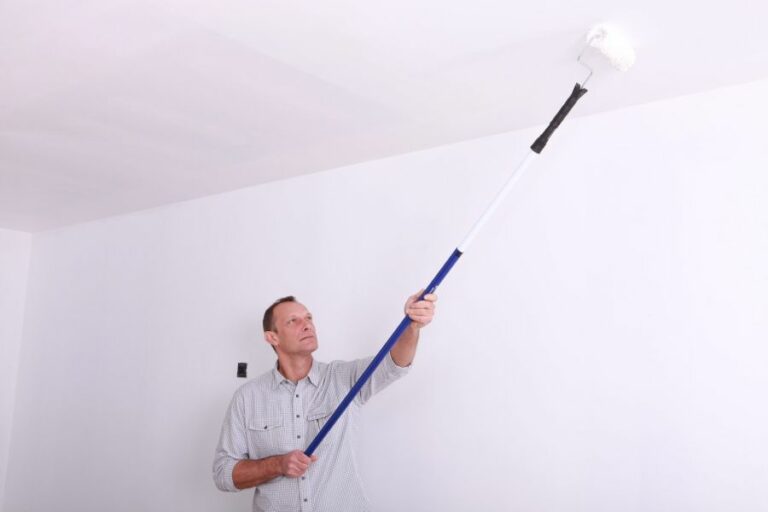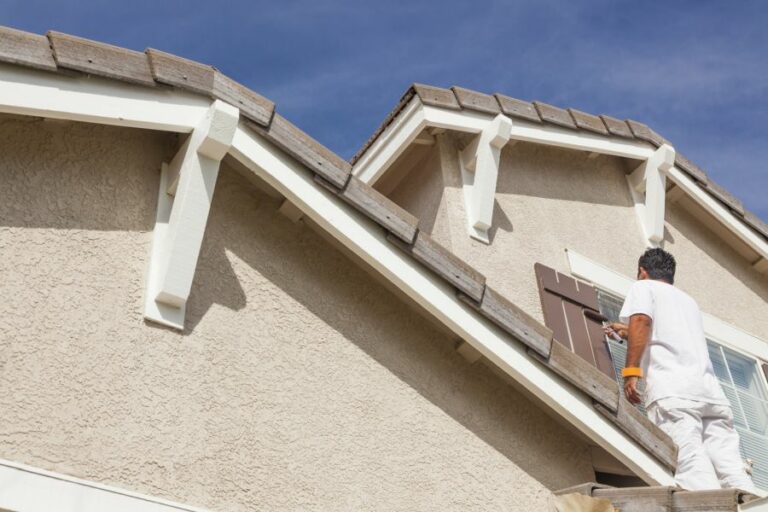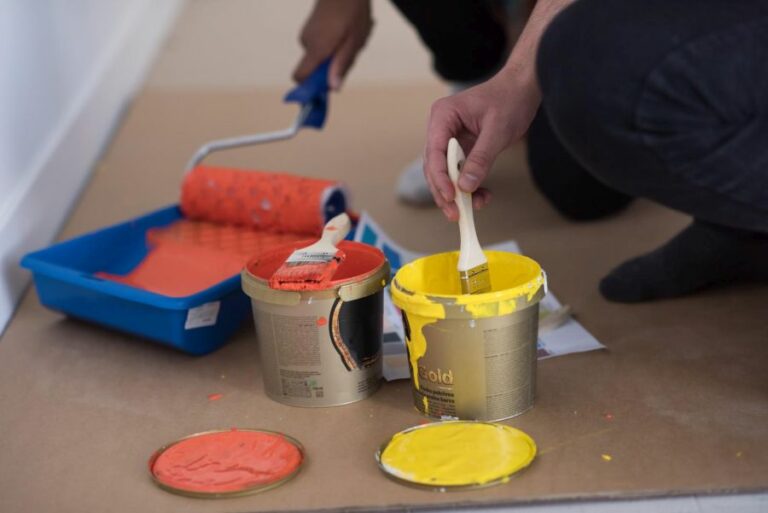Surface Preparation Challenges And Solutions For Historic Buildings
Surface preparation is essential when dealing with historic buildings, as it sets the foundation for restoration, preservation, and long-term durability. However, this sensitive task presents numerous challenges that require understanding the building’s historical context and technical complexities.
Surface preparation challenges and solutions for historic buildings:
Surface preparation in historic buildings faces challenges like mixed materials, deteriorating surfaces, and environmental concerns. Solutions include analyzing surface materials, using gentle cleaning methods, and addressing hazardous materials with qualified professionals. Employing appropriate techniques and consulting preservation experts ensures effective and sustainable conservation efforts.

Dive deeper into the complexities of surface preparation for historic buildings, the challenges faced, and the innovative solutions employed to preserve their timeless beauty. Keep reading to uncover more insights that will intrigue you and elevate your understanding of this fascinating field.
Contents
- 1 Overcoming Surface Preparation Challenges in Historic Structures
- 2 Crucial Considerations for Successful Historic Building Renovations
- 3 Effective Strategies to Conserve and Protect Old Buildings
- 4 Exploring Techniques and Methods in Historic Preservation
- 5 Four Essential Approaches to Handling Historic Property Treatments
Overcoming Surface Preparation Challenges in Historic Structures
• The Importance of Surface Preparation in Historic Buildings
Surface preparation is a crucial step in the restoration and maintenance of historic buildings. Proper surface preparation ensures the longevity and integrity of preservation treatments, which ultimately helps maintain the building’s historic fabric.
Inadequate surface preparation, on the other hand, can compromise the effectiveness of conservation efforts and may even cause irreversible damage to the building materials.
Understanding the unique challenges posed by historic surfaces and employing appropriate preparation techniques is essential for professionals in the field of historic preservation.
• Challenges in Surface Preparation for Historic Buildings
– Mixed or Unknown Surface Materials
Many historic buildings feature a variety of surface materials, including brick, stone, plaster, and wood. In some cases, multiple layers of paint or other coatings may be present, which can complicate the surface preparation process.
Determining the composition and condition of these materials is essential in order to choose the right cleaning and preparation methods.
Solution: Conduct a thorough analysis of the building’s surface materials before beginning any surface preparation work. This may include a visual examination, material identification tests, or consultation with a local historic preservation expert.
Research the history of the building in question, using documentation, photographs, or other resources to identify any previous changes to the structure or treatments applied to its surfaces.
– Deteriorating or Fragile Surfaces
Historic surfaces can be extremely delicate, showing signs of deterioration such as flaking paint, crumbling masonry, or cracked plaster. If not handled with care, the process of surface preparation can exacerbate existing damage or cause further deterioration.
Solution: Use gentle cleaning methods and materials, avoiding aggressive mechanical methods such as power washing, sandblasting, or grinding. Protect fragile surfaces by applying temporary protection, such as plastic sheeting, paper, or cloth.
Consult with a professional experienced in historic building preservation to ensure that the chosen preparation methods are suitable for the specific types of materials and conditions present in the building.
– Environmental Concerns
Surface preparation in historic buildings may sometimes require the removal of hazardous materials such as lead-based paint, asbestos, or harmful chemicals. This presents an environmental and safety risk to both workers and the surrounding environment.
Solution: Work with qualified professionals to identify and safely remove hazardous materials from the building surface.
Be sure to follow all applicable regulations and guidelines for hazardous materials removal and disposal, including the use of protective gear and the proper containment of waste materials.
For more information on addressing hazardous materials in historic buildings, visit the Environmental Protection Agency’s website.
• Recommended Surface Preparation Methods for Historic Buildings
– Chemical Cleaning
Chemical cleaning entails the use of specialized cleaning agents, such as detergents, solvents, or acids, to remove surface contaminants. This technique can be highly effective in removing soiling, stains, and coatings from a variety of historic materials without causing damage.
Recommendation: Always conduct a small-scale test in an inconspicuous area of the building to determine the suitability and effectiveness of the chosen cleaning agent.
Follow the manufacturer’s instructions for use and safety precautions closely. Wear appropriate protective equipment, and be sure to neutralize and rinse the treated areas thoroughly.
– Mechanical Cleaning
The use of hand tools, such as scrapers, brushes, and chisels, can be an effective and non-invasive method for surface preparation in historic buildings. This method allows for precise control over the removal process and is well-suited for small-scale projects or delicate surfaces.
Recommendation: Use the least invasive tool possible and work gradually to remove contaminants from the surface.
Be mindful of the pressure applied on the surface to avoid causing damage. Use plastic or wooden implements when working with particularly delicate materials.
– Steam Cleaning
Steam cleaning involves the use of low-pressure, high-temperature steam to remove contaminants from surfaces. This method can be particularly effective in cleaning masonry, as it is capable of dissolving built-up grime, algae, and other organic matter without causing harm to the substrate.
Recommendation: Ensure that the steam pressure is low enough to avoid causing damage to the surface material. Additionally, be cautious when using this method on porous or water-sensitive surfaces, as excessive moisture can cause damage in the form of efflorescence or spalling.
• Tips for Successful Surface Preparation in Historic Buildings
- Consider the building’s unique features, materials, and history when planning and executing surface preparation work.
- Consult with preservation professionals when unsure about the appropriate methods or techniques to use.
- Keep detailed records of all surface preparation work performed, including materials used, methodologies employed, and any findings or observations made during the process.
- Prioritize safety and environmental concerns, ensuring that all workers are trained and equipped to handle hazardous materials.
In conclusion, the importance of thorough and careful surface preparation in historic buildings cannot be overstated.
By addressing the unique challenges posed by these structures, professionals in the field of historic preservation can ensure that their conservation efforts are both effective and sustainable, ultimately contributing to the preservation of these valuable resources for future generations.
Crucial Considerations for Successful Historic Building Renovations
• Understanding the Building’s Significance
One of the first steps in renovating a historic building is to understand its significance. This includes researching the building’s history, architecture, and any notable events or individuals associated with it.
This information will help guide the renovation process and ensure that the building’s character and features are preserved. Additionally, it is important to identify any local, state, or federal historic designations the building may have, as different regulations and guidelines may apply.
For more information on researching a building’s history, the National Park Service’s Technical Preservation Services is an excellent resource.
• Developing a Renovation Plan
Once the building’s significance is understood, it is crucial to develop a plan for how best to restore and rehabilitate the structure while preserving its historic features. This plan should address the following:
- Building Condition Assessment: A thorough assessment of the building’s current condition is necessary to identify areas that need repair or restoration and to prioritize these repairs.
- Preservation vs. Rehabilitation: When planning the renovation, it is important to differentiate between preserving the original features of the building and rehabilitating it for modern use. Preservation focuses on maintaining the building’s historic materials and features, whereas rehabilitation involves adapting the building to meet current needs. Carefully consider the balance between these two approaches to make informed decisions about changes to the building.
- Compatibility of New Additions: If new additions or alterations are planned as part of the renovation, it is important to ensure that they are compatible with the building’s original architectural style, materials, and features. This may include choosing appropriate materials, colors, and design elements that complement the historic character of the building.
• Adhering to Historic Preservation Guidelines
Historic buildings often come with specific guidelines and regulations that must be followed during the renovation process. These may include:
- Local, State, and Federal Regulations: Depending on the building’s designations, different sets of regulations may apply. Be sure to research and adhere to all applicable guidelines during the renovation process.
- Secretary of the Interior’s Standards for the Treatment of Historic Properties: This set of guidelines, developed by the National Park Service, provides recommendations for preserving, rehabilitating, restoring, and reconstructing historic buildings. These standards can help guide the renovation process and ensure that the building’s historic character is maintained.
- Review and Approval Process: In some instances, proposed changes to a historic building may require review and approval from a local historic commission or board. Familiarize yourself with this process and ensure that any necessary approvals are obtained before beginning the renovation.
• Addressing Structural Issues
Historic buildings, particularly those in disrepair, may have structural issues that require stabilization or repair. These issues should be addressed as early as possible to prevent further deterioration or damage.
In some cases, professional structural engineers with experience in historic preservation may need to be consulted to ensure that structural repairs are carried out in a manner that is sensitive to the historic fabric of the building.
• Preserving and Restoring Historic Materials and Features
Throughout the renovation process, special attention must be given to preserving and restoring the building’s historic materials and features. This includes:
- Restoration Techniques: Employ appropriate restoration techniques, such as repairing damaged or deteriorated elements and cleaning historic surfaces, to maintain the building’s character.
- Reversible Interventions: When making changes to the building, use reversible interventions, meaning alterations that can be easily removed or reversed in the future, to minimize permanent damage to historic materials.
- Replacement of Damaged Features: In some cases, it may be necessary to replace damaged or missing historic features. When doing so, use materials that closely match the original in appearance, texture, and composition.
• Working with Preservation Professionals
Throughout the renovation process, it is important to work closely with preservation professionals, such as architects, contractors, and consultants, who have experience in historic preservation.
These professionals can provide guidance on appropriate restoration techniques, materials, and best practices for preserving the building’s historic character. Additionally, they can help navigate the often complex regulatory and approval processes associated with renovating historic properties.
In conclusion, renovating a historic building is a complex and rewarding process that requires careful planning, understanding of the building’s significance, adherence to preservation guidelines, and collaboration with experienced professionals.
By taking these factors into consideration, the building’s historic character can be preserved while adapting it for modern use, ensuring its continued relevance and enjoyment for future generations.
| Key Factors |
|---|
| Preserving the historical integrity and character of the building |
| Compliance with local building codes and preservation regulations |
| Assessing the physical condition of the building and identifying necessary repairs |
| Thorough documentation of the building’s existing condition and renovation process |
| Integration of modern technologies and systems while respecting the building’s historic fabric |
| Selection of appropriate materials and construction techniques |
| Coordination with preservation specialists and local authorities |
| Planning for accessibility and safety improvements |
| Mitigating potential environmental hazards |
| Ensuring long-term maintenance and sustainability of the renovated building |
Effective Strategies to Conserve and Protect Old Buildings
Preserving old buildings is crucial for maintaining our cultural heritage, enhancing the aesthetic value of our communities, and fostering sustainable development. Over the years, I have discovered several effective methods to preserve and maintain historic structures.
• Routine Maintenance
The most crucial aspect of preserving old buildings is proper routine maintenance. Ensuring that roofs are watertight, windows are sealed, and masonry is in good condition can prevent water infiltration, which can cause significant structural damage.
Regular inspections and timely repairs are essential to prolong the life of a historic building. For more information on maintenance practices for historic buildings, please refer to this guide by The National Park Service.
• Structural Stabilization
Historic buildings often suffer from structural issues such as foundation settlement, wood rot, or termites. In these cases, it is essential to stabilize the building and address these problems before attempting any restoration work.
This procedure may involve repairing or replacing damaged structural elements, adding support to weak areas, or introducing new structural systems such as steel or concrete.
A structural engineer with experience in historic buildings should always be consulted to assess and design the appropriate stabilization measures.
• Respect the Building’s Historic Integrity
When making repairs or alterations to a historic building, it is vital to respect its historical integrity. This means preserving original materials and features whenever possible, and if replacements are necessary, they should match the original design and materials.
Architects and preservation specialists should be consulted to ensure that any changes are made sensitively and in accordance with guidelines set by local, state, or national preservation organizations.
• Adaptive Reuse
One of the most effective ways to preserve old buildings is to give them a new purpose through adaptive reuse.
By repurposing a historic building for contemporary needs, such as converting a disused factory into apartments or an old church into an art gallery, its value is recognized, and it is saved from demolition.
Adaptive reuse not only helps to protect historic buildings but also promotes sustainable urban development, as it reduces the need for new construction and conserves resources.
• Grants and Tax Incentives
Financial incentives can make a significant difference in the preservation of old buildings. Many countries, states, and municipalities offer grants for the repair and restoration of historic properties.
In the United States, federal tax credits are available for the rehabilitation of certified historic structures, making it economically viable for property owners to invest in preservation.
• Legal Protection
Advocating for legal protection is another essential aspect of preserving old buildings. Historic preservation laws and regulations protect historic buildings and environments from inappropriate changes or demolition.
These laws often require that any alterations, new construction, or demolitions within designated historic areas be reviewed and approved by a preservation commission.
Getting involved in local and national heritage organizations can be an effective way to advocate for stronger legal protections for old buildings.
• Raise Awareness and Build Support
Increasing public awareness and appreciation of historic buildings is an essential part of preservation efforts. People are more likely to support the conservation of historic structures if they understand their value and significance.
Encourage local schools and communities to learn about their history, organize walking tours, and host events to raise awareness of the importance of preserving old buildings.
• Technical Assistance and Training
Access to expertise and resources is critical for the proper preservation of historic buildings.
Providing technical assistance and training to property owners, architects, engineers, contractors, and craftsmen in the proper techniques of preserving and restoring old buildings ensures that restoration work is carried out with due care and respect for the building’s historic character.
Reach out to historic preservation organizations, universities, or local government agencies to find resources and training opportunities on historic preservation.
• Develop a Preservation Plan
Creating a comprehensive preservation plan is an effective way to identify and prioritize preservation needs and outline a strategy for their implementation.
A preservation plan should include detailed information about the building’s history, its current condition, necessary repairs, and recommendations for future maintenance and improvements.
This plan can be a valuable tool for property owners, preservation organizations, and local governments in securing funding and implementing long-term preservation strategies.
In conclusion, preserving old buildings requires a combination of regular maintenance, structural stabilization, financial incentives, legal protection, and raising public awareness.
By adopting these measures and working together with preservation professionals, organizations, and communities, we can ensure that our historic buildings continue to enrich our lives for generations to come.
Preservation Method | Description |
|---|---|
Restoration | Restoring the building to its original state through repair and replacement of original materials or elements |
Rehabilitation | Altering or adding to a building while preserving the original structure and design in order to make it functional for modern use |
Adaptive reuse | Repurposing an old building for a new use while preserving its historical and architectural significance |
Preservation | Maintaining the building in its current state, with routine maintenance and repairs to prevent further deterioration |
Conservation | Preserving the cultural and historical value of a building through a variety of methods, including structural repairs, building stabilization, and protection from environmental threats |
Exploring Techniques and Methods in Historic Preservation
• Identifying and Evaluating Historic Resources
One of the first steps in historic preservation is to identify and evaluate the significance of the resource. This involves conducting research on the history of the property, its architectural style, and the individuals and events associated with it.
The National Register of Historic Places (NRHP) and local and state registers can be helpful resources in this process.
– Conducting a Cultural Resource Survey
A cultural resource survey is an important tool in identifying historic properties. This involves gathering information about the property’s architectural and historical significance, as well as its condition, through fieldwork, historical research, and consultation with relevant stakeholders.
The survey results can be used to determine whether the property meets the criteria for listing in a historic register.
– Applying the Secretary of the Interior’s Standards
The Secretary of the Interior’s Standards for the Treatment of Historic Properties provides guidance on the preservation, rehabilitation, restoration, and reconstruction of historic buildings.
These standards should be used when planning a preservation project to ensure that the character-defining features of a historic property are retained and preserved.
• Planning and Implementing Historic Preservation Projects
Once a historic property has been identified and evaluated, planning and implementing preservation projects can begin. This involves the appropriate treatment of the resource, based on the Secretary of the Interior’s Standards, as well as obtaining necessary approvals and permits.
– Developing a Preservation Plan
A preservation plan is an essential tool in guiding the long-term care and maintenance of a historic property. This document outlines strategies to address the property’s needs, including routine maintenance, repairs, and improvements.
A well-crafted preservation plan will ensure that the project’s goals are met while minimizing potential impacts on the property’s historic character.
– Engaging with Professionals and Craftsmen
Successful historic preservation projects often require the expertise of preservation professionals and skilled craftsmen. From architects and engineers to masons and carpenters, these individuals possess the knowledge and experience necessary to address the unique needs of historic properties.
It is important to consult with experts and craftsmen in a preservation project’s planning and implementation stages.
– Obtaining Funding and Incentives
Historic preservation projects can be expensive and often require financial assistance. There are various funding sources and incentives available to property owners, including federal and state tax credits, preservation grants, and low-interest loans.
These resources can play a critical role in the successful completion of preservation projects.
– Ensuring Compliance with Regulations
Historic properties are often subject to a range of regulations related to their preservation. This can include local historic preservation ordinances, building codes, and zoning guidelines. Ensuring compliance with these regulations is an essential component of a successful preservation project.
• Maintenance and Stewardship
The ongoing maintenance and stewardship of historic properties are critical in ensuring their long-term preservation. This involves regular inspections, routine maintenance, and timely repairs.
– Conducting Regular Inspections
Regular inspections are essential for identifying and addressing maintenance and repair needs. This can include reviewing the condition of the building’s exterior, interior, and structural systems, as well as assessing the performance of mechanical, electrical, and plumbing systems.
– Performing Routine Maintenance
Routine maintenance is key to preserving historic properties. This includes tasks such as cleaning gutters and downspouts, inspecting and repairing roofing materials, and repointing masonry joints. Regular maintenance helps prevent deterioration and can extend the life of historic features and materials.
– Addressing Repair Needs
When repair needs are identified during inspections or maintenance, it is important to address them in a timely manner. This may involve repairing or replacing damaged or worn materials, addressing water infiltration issues, or making structural repairs.
Prompt attention to repair needs can help prevent further damage and costly interventions in the future.
• Education and Advocacy
Promoting the importance of historic preservation and fostering a culture of preservation within communities are essential aspects of safeguarding historic resources.
– Education and Outreach
Sharing information about the importance of historic preservation and the rich architectural and cultural heritage of a community can help build support for preservation efforts.
This can be achieved through educational programs, workshops, and tours, as well as the use of interpretive materials and digital platforms.
– Building Partnerships and Coalitions
Collaboration and partnerships are key in advancing preservation efforts. By engaging diverse stakeholders, such as local businesses, neighborhood associations, and heritage organizations, a broader base of support can be developed for preservation projects.
– Advocacy and Policy Development
Preservation advocates play an important role in shaping local, state, and national policies that affect historic properties. By participating in advocacy efforts and supporting sound preservation policy, individuals and organizations can help create a more favorable climate for historic preservation.
In conclusion, historic preservation involves a combination of research, planning, implementation, maintenance, and advocacy.
By employing these techniques and working with preservation professionals, property owners, and community members, our cultural heritage can be preserved for future generations’ enjoyment.
Technique | Description |
|---|---|
Documentation | Recording the history, appearance, and condition of a historic property through photographs, drawings, and written narratives. |
Stabilization | Applying measures to stop or slow down the deterioration process while maintaining the existing form and materials of a historic property. |
Preservation | Maintaining the existing form, integrity, and materials of a historic property by applying regular maintenance and repairs. |
Rehabilitation | Adapting a historic property to meet modern needs and uses while preserving its significant historic features. |
Restoration | Returning a historic property to its appearance during a specific period of time by removing or modifying features from other periods and reconstructing missing features. |
Reconstruction | Recreating a vanished or non-surviving historic property with new materials, mostly for interpretive purposes. |
Four Essential Approaches to Handling Historic Property Treatments
Preserving and maintaining historic properties is an essential aspect of cultural heritage management. In order to ensure that these properties are treated appropriately and retain their historical integrity, various approaches and guidelines have been established.
• Preservation: Retaining Historical Integrity
Preservation is focused on maintaining and protecting the existing form, materials, and features of a historic property. This approach is the least invasive, as it aims to retain the property’s original character and minimize the impact of ongoing deterioration.
When considering a preservation approach, it is crucial to identify the property’s unique historical features and materials. This might include original woodwork, masonry, or architectural elements.
Once these features have been identified, a preservation plan should be developed to address potential threats and establish a maintenance schedule to ensure the property’s long-term vitality.
In my experience, adopting a preservation mindset requires a thorough understanding of the property’s history, a commitment to routine maintenance, and a dedication to using historically-appropriate materials and techniques when repairs or interventions are needed.
For more information on preservation best practices, I recommend referring to the National Park Service’s Preservation Briefs.
• Rehabilitation: Adapting to Contemporary Needs
While preservation is focused on maintaining a historic property’s original character, rehabilitation recognizes the need for modern adaptations and alterations. This approach often involves repurposing historic properties for new uses or updating them to meet current codes and standards.
When planning a rehabilitation project, it is essential to balance the property’s historical character with contemporary requirements. This might involve integrating modern systems or technologies, optimizing accessibility, or altering spaces to better accommodate current functions or activities.
Throughout my career, successful rehabilitation projects have typically involved a combination of preservation and modernization.
I recommend engaging a team of architects, engineers, and preservation specialists to ensure that any proposed changes contribute to the property’s long-term vitality while respecting its historical significance.
The Secretary of the Interior’s Standards for Rehabilitation can be an invaluable resource for guiding this process.
• Restoration: Recapturing a Specific Time Period
For some historic properties, it may be desirable to return them to a specific time period by removing later additions or alterations that do not contribute to their original character.
Restoration involves great attention to detail, as it seeks to accurately recreate the property’s appearance during a specific time in its history.
Restoration projects typically involve considerable research, documentation, and analysis to define the property’s original condition. This approach often requires the use of traditional materials and methods to ensure accuracy and consistency with the property’s historical identity.
In my experience, restoration projects can be both rewarding and challenging. For optimal results, I recommend working with knowledgeable professionals to develop a comprehensive restoration plan that fully considers the scope, costs, and historical significance of the property.
• Reconstruction: Rebuilding a Lost Past
In cases where a historic property has been severely damaged or lost, reconstruction is an approach that may be considered. This involves a significant level of research and documentation, as well as a commitment to maintaining historical accuracy during the rebuilding process.
Reconstruction projects can be complex due to the challenges of recreating a lost property with limited available information. Therefore, it is crucial to work closely with knowledgeable professionals, such as historians, architects, and craftspeople, throughout the project.
I recommend pursuing reconstruction projects with caution, as they should only be considered when sufficient historical documentation exists to warrant a faithful representation of the original property. For further guidance on reconstruction, refer to the Secretary of the Interior’s Standards for Reconstruction.
• Conclusion
In conclusion, the appropriate approach to the treatment of historic properties will depend on the specific property, its historical significance, its condition, and its intended use.
By understanding the principles of Preservation, Rehabilitation, Restoration, and Reconstruction, we can ensure that these valuable cultural assets are treated with respect and continue to enrich our lives and communities for generations to come.







